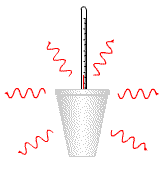|
Calorimetry can be used to find the energy change in chemical reactions. This is much easier to carry out in aqueous solutions. Reaction enthalpy can be used in conjunction with Hess' law to determine the enthalpy change of reactions who's energy measurement would otherwise be unfeasible. |
 |
The decomposition of calcium carbonate
Calcium carbonate decomposes when heated to give calcium oxide and carbon dioxide.
CaCO3(s)  CaO(s) + CO2(g)
CaO(s) + CO2(g)
It is not realistically possible to measure the enthalpy change of this reaction directly, but using the fact that both calcium carbonate and calcium oxide react directly with hydrochloric acid, a Hess' law cycle can be constructed to give the enthalpy change of decomposition of calcium carbonate.
CaCO3(s) + 2HCl(aq)  CaCl2(aq) + CO2(g) + H2O(l)
CaCl2(aq) + CO2(g) + H2O(l)
CaO(s) + 2HCl(aq)  CaCl2(aq) + H2O(l)
CaCl2(aq) + H2O(l)
Part 1 - reaction of calcium carbonate with hydrochloric acid
- 1 Accurately weigh approximately 4 g of calcium carbonate (about 0.04 mol).
- 2 Using a measuring cylinder collect 50 cm3 of 2M hydrochloric acid (an excess) and record its temperature
- 3 Add the hydrochloric acid to the calcium carbonate in a weighed polystyrene beaker with lid.
- 4 Stir and record the highest temperature reached.
- 5 Reweigh the polystyrene cup, lid and contents.
Part 2 - reaction of calcium oxide with hydrochloric acid
- 1 Repeat the procedure above using approximately 2 g of calcium oxide with 50 cm3 of 2M HCl
Once again all quantitative and qualitative data must be recorded with inaccuracy and instrumental tolerance.
Raw data - part 1
Mass of calcium carbonate used: 4.10 g ± 0.01
Mass of polystyrene beaker and lid: 27.34 g ± 0.01
Initial temperature of acid: 21.5 ºC ± 0.5
Final temperature of reaction mixture: 27.0 ºC ± 0.5
Mass of beaker, lid and products: 81.23 g ± 0.01
Raw data - part 2
Mass of calcium oxide used: 1.90 g ± 0.01
Mass of polystyrene beaker and lid: 27.66 g ± 0.01
Initial temperature of acid: 21.0 ºC ± 0.5
Final temperature of reaction mixture: 41.5 ºC ± 0.5
Mass of beaker, lid and products: 83.71 g ± 0.01
Data analysis
Calcium carbonate + hydrochloric acid
Moles of calcium carbonate = mass/Mr = 4.10/100 = 0.041 mol
Temperature change = 27.0 - 21.5 = 5.5 ºC
Mass of solution being heated = 81.23 - 27.34 = 53.89 g = 0.0539 kg
Energy change for calcium carbonate + hydrochloric acid = mcΔT = 0.0539 x 4.18 x 5.5 = -1.24 kJ (negative as it's exothermic)
Hence energy per mole = -1.24/0.041 = -30.2 kJ mol-1
Calcium oxide + hydrochloric acid
Moles of calcium oxide used = mass/Mr = 1.90/56 = 0.034 mol
Temperature change = 41.5 - 21.0 = 20.5 ºC
Mass of solution being heated = 83.71 - 27.66 = 56.05 g = 0.0561 kg
Energy change for calcium carbonate + hydrochloric acid = mcΔT = 0.0561 x 4.18 x 20.5 = -4.80 kJ (negative as it's exothermic)
Hence energy per mole = -4.80/0.034 = -141.3 kJ mol-1
Hess' cycle for the decomposition
ΔH1CaCO3(s)
+ 2HCl(aq)  CaCl2(aq) + CO2(g)
+ H2O(l)
CaCl2(aq) + CO2(g)
+ H2O(l)
ΔH2CaO(s)
+ 2HCl(aq)  CaCl2(aq) + H2O(l)
CaCl2(aq) + H2O(l)
Enthalpy change of decomposition = ΔH1 - ΔH2
Enthalpy change of decomposition = -30.2 - -141.3 = +110.1 kJ
Treatment of errors and inaccuracies
Calcium carbonate inaccuracies
Mass of calcium carbonate = 4.10 g ± 0.01 = 100 x 0.01/4.10 % = 0.24%
Temperature change = 5.5 ºC ± 1 = 100 x 1/5.5 % = 18.2 %
Mass of heated solution = 53.89 g ± 0.02 = 100 x 0.02/53.89 % = 0.04 %
Total percentage inaccuracy = 18.5 %
Calcium oxide
Mass of calcium oxide used = 1.90 g ± 0.01 = 100 x 0.01/1.90 % = 0.53 %
Temperature change = 20.5 ºC ± 1 = 100 x 1/20.5 % = 4.88 %
Mass of solution being heated = 56.05 g ± 0.02 = 100 x 0.02/56.1 % = 0.04%
Total percentage inaccuracy = 5.5 %
Summed percentage inaccuracy for both experiments = 18.5 + 5.5 = 24%
Hence the enthalpy change for decomposition of calcium carbonate = +110.1 kJ ± 26.4
Conclusion and evaluation
The experiment has a high percentage inaccuracy with the major contributor being the temperature change for the reaction between calcium carbonate and hydrochloric acid.
The literature value for the decomposition enthalpy is +178 kJ, which is outside the error limits imposed by the instruments used.
This suggests that there are other systematic inaccuracies involved. Heat losses to the environment have not been considered, although the small change in temperature during the reaction should limit this.
One improvement could be to use a larger amount of calcium carbonate with the same volume of hydrochloric acid with a higher concentration. This would lead to a larger temperature change and reduce the percentage error.
Clearly the results above are based on one experiment and repetitions would be needed to reduce random error.
